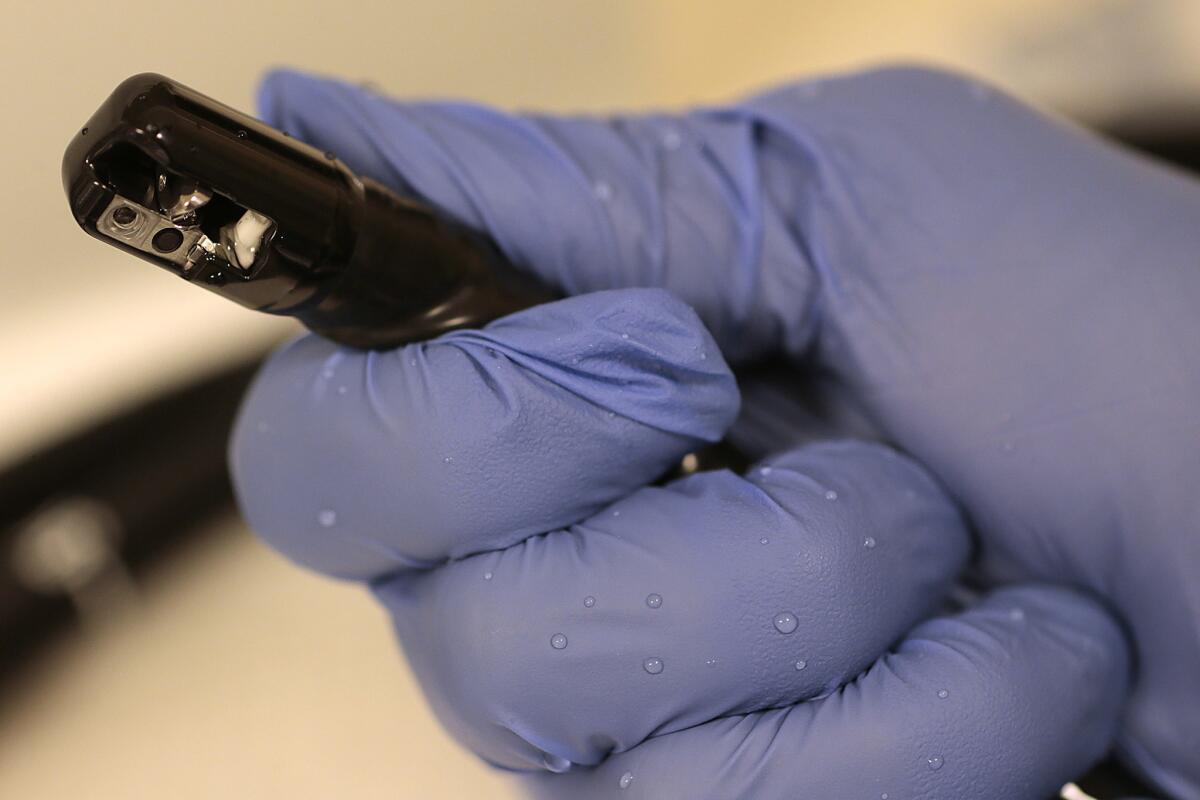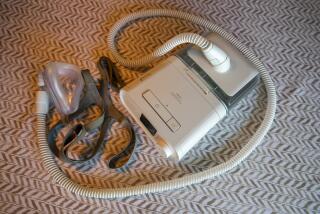Olympus to recall and redesign medical scope linked to superbug outbreaks

An Olympus duodenoscope is cleaned at Los Angeles County/USC Medical Center on Nov. 9, 2015.
- Share via
Olympus Corp. said Friday that it would voluntarily recall and redesign a troubled medical scope that has been linked to deadly patient infections around the world.
The company, which sells about 85% of the duodenoscopes used in the United States, said it would revamp an internal mechanism inside the reusable device that had been almost impossible to disinfect before being used in the next patient.
The recall and redesign announcement comes two days after a U.S. Senate report concluded that 25 outbreaks — including two in Los Angeles in which three people died — were linked to dirty scopes made by Olympus and two other manufacturers.
Join the conversation on Facebook >>
A series of Times stories last year reported that Olympus knew of the potential flaws in the scope as early as the spring of 2012 but failed to alert American hospitals or regulators.
Since then, at least 141 patients in nine U.S. cities were infected, investigators found. Many of the illnesses were from a superbug known as CRE, or carbapenem-resistant Enterobacteriaceae, which can kill as many as half its victims.
The U.S. Food and Drug Administration said Friday that it had approved Olympus’ new design of the device, which is called a duodenoscope.
American doctors use the scope nearly 700,000 times a year in a procedure known as ERCP, or endoscopic retrograde cholangiopancreatography. Doctors thread the flexible scope down a patient’s throat and into the digestive tract to diagnose and treat cancers, gallstones and other conditions.
The voluntary recall marks a major turnaround for Olympus, which for years has blamed the growing number of infections on hospitals, saying they improperly cleaned the scopes.
In 2010, Olympus engineers had modified the $40,000 scope to seal a narrow internal channel to keep out blood and other infectious material. The change aimed to make the scope easier to clean and followed similar redesigns by its two rivals, Pentax and Fuji.
But three independent investigations — the first in early 2012 — found the design could allow bacteria to remain inside the scope even after it was cleaned according to Olympus’ instructions.
The Senate report backed up those findings, noting it “is now evident” that such models can “trap and transmit bacteria” even after cleaning.
In the 301-page report, the investigators said Olympus and two other manufacturers “failed at every level to meet basic expectations of transparency and openness and to actively engage with FDA to address contamination issues.”
“This disregard for the spirit, and sometimes the letter, of the law resulted in potentially preventable serious and potentially fatal illnesses in hospitals around the world,” they wrote.
The company disclosed in April that the U.S. Justice Department is investigating its role in the outbreaks.
Olympus’ recall did not come soon enough for some patients.
“It infuriates me to know they knew about this in 2012,” said Steven Wilkinson-St. George, who fell seriously ill from CRE after a scope procedure at UCLA’s Ronald Reagon Medical Center in December 2014. “This should have been done years ago.”
Wilkinson-St. George, 56, of Lompoc, said he dropped from 170 to 110 pounds and often thought he would die as he spent 29 days in the hospital on high doses of antibiotics. He has filed a lawsuit against Olympus.
Even as questions persisted about the scope’s design and outbreaks continued, Olympus profited. Once known as a camera company, the Tokyo company’s medical devices now account for nearly 75% of its $7 billion in annual revenue. Sales of its scopes surged 18% to $1.4 billion for the six months that ended in September, and overall company profit jumped 60% to $294 million.
Under the steps outlined by Olympus and the FDA on Friday, the company will begin collecting the scopes from hospitals next month to replace the so-called elevator mechanism.
The FDA said the company had modified the design to create a tighter seal and reduce the risk that patient fluids and tissue could leak into the closed channel. Olympus executives estimate the firm can replace the mechanism in all 4,400 devices in use in the U.S. by August, the agency said.
Until then, hospitals can continue to use the scope — known as the TJF-Q180V — but should “meticulously follow” the company’s cleaning instructions, the FDA said.
Olympus will also begin conducting annual inspections of each scope being used by hospitals to identify any wear and tear or “the presence of attached debris at the scope’s tip,” the agency said. Such findings would “require replacement of the potentially contaminated parts,” the FDA said.
It is unclear whether manufacturers Pentax and Fujifilm will issue a similar redesign. Pentax declined to comment Friday. Fujifilm did not respond to questions by The Times.
The FDA said Friday that it had received 319 reports of infections or similar problems tied to the scopes. Olympus’ scopes accounted for 273 of those reports, while 42 related to the Pentax device. Four reports detailed problems with Fujifilm’s scope.
The lawmaker who launched the Senate investigation praised the move and urged further action.
“These devices exposed far too many patients and their families to unacceptable risks, and I am pleased to see that the FDA and manufacturers have taken additional actions to protect patients in the future,” said Sen. Patty Murray (D-Wash.)
Among the outbreaks was one at Virginia Mason Medical Center in Seattle, where dozens of patients were sickened, including 18 who died.
The report — written by the minority staff of the Senate committee on health, education, labor and pensions, and released Wednesday — cited repeated failures by manufacturers, regulators and hospitals to report outbreaks. The missteps in oversight allowed patients to remain at risk “with life-threatening consequences,” investigators concluded.
“The steps taken today are important,” Murray said in a statement, “but there is much more we need to do to make sure the FDA can respond quickly and appropriately when problems with medical devices occur.”
MORE FROM BUSINESS
U.S. to invest billions in self-driving cars
Amazon is dropping Prime price to $73 for the weekend
BMW’s 328i xDrive Wagon: a luxury kid-hauler that hauls
More to Read
Inside the business of entertainment
The Wide Shot brings you news, analysis and insights on everything from streaming wars to production — and what it all means for the future.
You may occasionally receive promotional content from the Los Angeles Times.











